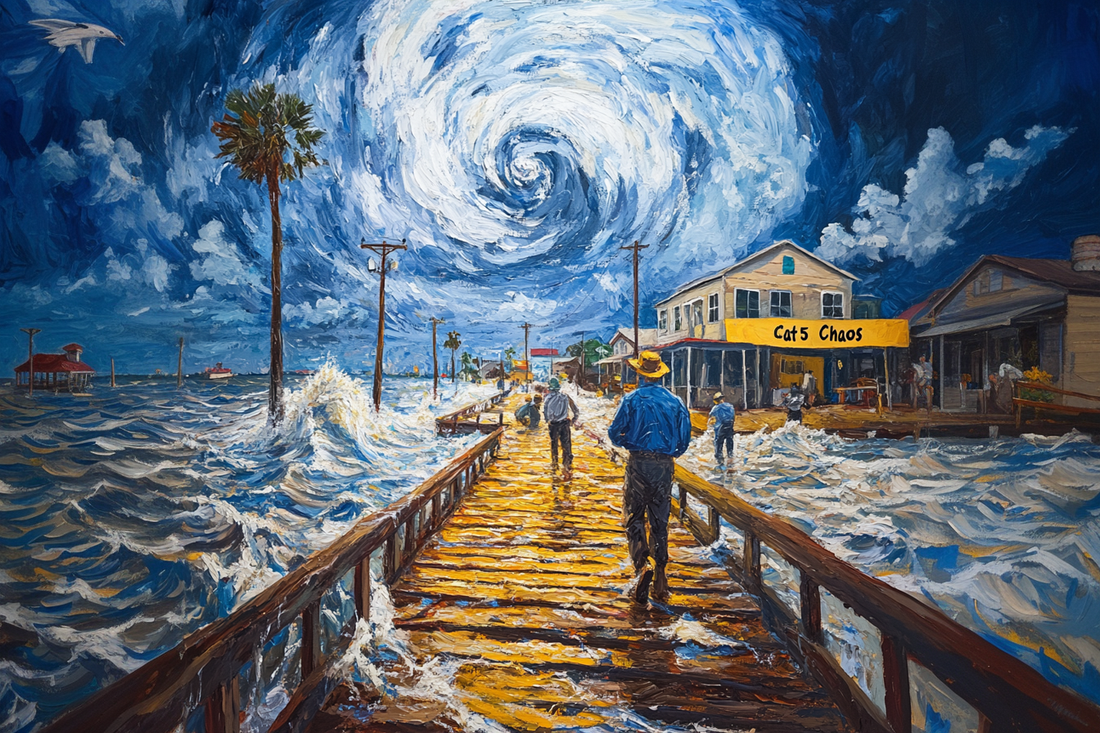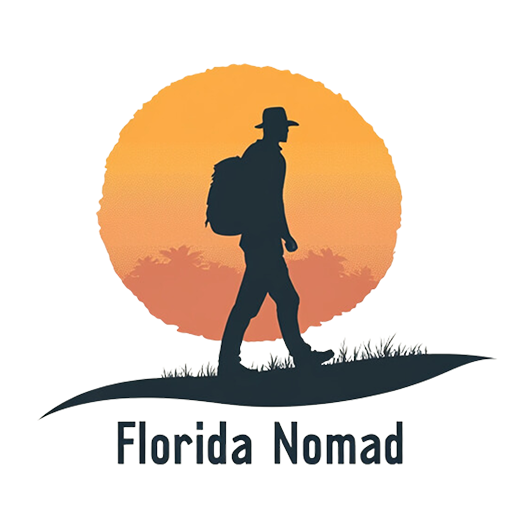
Hurricanes in Florida: How to Prepare for Storm Season
Share
June kicks off hurricane season in Florida, a six-month period that’s as much a part of life here as palm trees and sunny beaches. At Florida Nomad, we’re all about celebrating the Sunshine State through our apparel, but we also know living here means being ready for hurricanes.
This guide is your go-to for understanding hurricanes in Florida, why they hit so often, and how to prepare—whether you’re a lifelong resident or a new transplant. Let’s get into what you need to know to stay safe and keep rocking your Florida vibe.
Why Florida Gets Hit So Often
Florida’s geography is a hurricane magnet. Jutting out into the Atlantic Ocean and Gulf of America (renamed from Gulf of Mexico by a 2024 executive order), the state is surrounded by warm waters that fuel tropical storms.
The Atlantic hurricane season runs from June 1 to November 30, peaking around September 10. Storms typically form in the Atlantic basin—covering the Atlantic Ocean, Caribbean Sea, and Gulf of America—and Florida’s position puts it right in their path.
Since 1851, Florida has seen about 41% of all U.S. hurricane landfalls, more than any other state. From the Panhandle to the Keys, no part of the state is immune. Coastal areas face storm surge, while inland spots deal with flooding and tornadoes. The state’s flat terrain and low elevation make it especially vulnerable to water damage, whether from storm surge or heavy rain.
Here’s a breakdown of hurricane landfall risks across Florida, based on historical data:
| Region | Chance of Hurricane Landfall | Common Threats |
|---|---|---|
| Northwest (Panhandle) | 1 in 3 years | Storm surge, high winds |
| West Coast (Tampa to Naples) | 1 in 4 years | Storm surge, flooding |
| East Coast (Miami to Jacksonville) | 1 in 5 years | Wind, tornadoes, coastal erosion |
| South (Keys to Everglades) | 1 in 6 years | Surge, extreme rain |
This table shows every region faces risk, with the west coast and Panhandle seeing slightly higher odds. Major hurricanes (Category 3 or higher) are less common but can strike anywhere, as seen with storms like Andrew (1992) and Michael (2018).
What Fuels Hurricanes
Hurricanes thrive on warm ocean water, typically above 80°F, which Florida’s surrounding seas provide in spades during summer and fall. Warm water evaporates, creating moist air that rises and forms thunderstorms. If conditions are right—low wind shear, high humidity, and a spark like a tropical wave—these storms can spin into a hurricane.
Florida’s hurricanes often come from:
- The Atlantic: Storms forming off Africa’s coast can travel west, hitting the east coast or curving into the Gulf.
- The Caribbean: Tropical waves here can quickly intensify, threatening South Florida or the Gulf coast.
- The Gulf of America: Warm, shallow waters can spin up storms close to home, giving less warning time.
Other factors, like the Bermuda-Azores high-pressure system, steer storms toward Florida or away. Atmospheric patterns like La Niña, which reduces wind shear, can make seasons busier, while El Niño often calms things down. These patterns shift year to year, but Florida’s risk stays high.
The Impact of Hurricanes
Hurricanes bring more than wind. Storm surge—seawater pushed ashore by a storm’s winds—is often the deadliest threat, flooding coastal areas. Inland, heavy rain can cause rivers to overflow, as seen in Central Florida during Hurricane Ian (2022). Tornadoes are another risk; some storms spawn dozens across the state. Power outages, downed trees, and debris can disrupt life for weeks.
Economically, hurricanes hit hard. A single storm can cause billions in damage, from destroyed homes to shuttered businesses. Communities often take years to recover, especially in rural areas like the Big Bend.
For residents, the emotional toll is real—evacuating, rebuilding, or losing sentimental belongings takes a lot out of you.
How to Prepare for Hurricane Season
Being ready starts before June 1. Here’s a practical plan to keep you and your family safe, no matter the storm.
Make a Plan
- Know Your Zone: Check your county’s website to see if you’re in an evacuation zone. Coastal and low-lying areas are most at risk for surge. Apps like FEMA’s can help.
- Plan for Everyone: Account for kids, pets, or elderly family members. Decide where you’ll go if you evacuate—a friend’s house, hotel, or shelter. You don’t always need to leave the state; sometimes a few miles inland is enough.
- Stay in the Loop: Sign up for local alerts at FloridaDisaster.org/AlertFlorida. Get a weather radio for updates if power and cell service fail.
Protect Your Home
- Inspect Your Property: Homes built after 2002 follow stricter codes, but older ones may need work. Install hurricane shutters or board windows with plywood. Secure loose roof tiles or gutters.
- Clear Debris: Trim weak branches or dead trees that could fly in high winds. Store outdoor furniture or grills before a storm.
- Check Insurance: Review your homeowner’s policy. Most don’t cover floods, so look into flood insurance through the National Flood Insurance Program. Act early—it takes 30 days to kick in.
Build a Disaster Kit
Stock up for at least seven days. Here’s what you need:
- Water (one gallon per person per day)
- Non-perishable food (canned goods, granola bars)
- Flashlights and batteries
- First-aid kit and medications
- Pet supplies
- Cash (ATMs may not work)
- Phone chargers or power banks
- Tarps, rope, or duct tape for quick fixes
Store your kit in a waterproof container and check it yearly. If you’re tight on space, prioritize water and food.
Stay Informed
- Track Storms: The National Hurricane Center posts updates at nhc.noaa.gov. Local news and apps like AccuWeather are solid too.
- Know the Alerts: A hurricane watch means conditions are possible within 48 hours. A warning means they’re expected within 36 hours. If a warning hits, act fast—evacuate if ordered or hunker down.
What to Do During a Storm
If you stay home:
- Stay indoors, away from windows. Use a safe room like an interior bathroom or closet.
- Keep your radio on for updates.
- Avoid using candles—flashlights are safer.
If you evacuate:
- Follow official routes to avoid traffic jams.
- Bring your disaster kit, ID, and key documents.
- Let family know your plans.
Never drive through flooded roads. Just six inches of water can sweep a car away. If power lines are down, assume they’re live and stay clear.
After the Storm
- Stay Safe: Wait for officials to say it’s okay to return. Watch for hazards like downed wires, flooded roads, or damaged buildings.
- Document Damage: Take photos for insurance claims. File claims as soon as you can.
- Help Out: Check on neighbors, especially seniors or those with disabilities. Volunteer or donate to local relief efforts if you’re able.
Historical Trends and What They Tell Us
Florida’s hurricane history shows no corner is spared. The state averages a hurricane landfall every two years, with major hurricanes hitting about once a decade. South Florida took a beating from Andrew (1992) and Wilma (2005), while the Panhandle got slammed by Michael (2018). Central Florida, often seen as safer, flooded badly during Ian (2022).
Here’s a chart of major hurricane landfalls by decade, based on NOAA data:
This chart shows spikes in the 2000s and 2020s, but every decade brings at least one major storm. The takeaway? Preparation isn’t a one-off—it’s a lifestyle.
Living with Hurricanes
Hurricanes are part of Florida’s reality, but they don’t define it. From the beaches of Miami to the marshes of the Everglades, this state’s beauty and spirit shine through. At Florida Nomad, we’re proud to rep that spirit with our apparel, and we’re just as committed to helping you stay ready for whatever nature throws your way.
Keep this guide handy, check your supplies, and stay alert as each season approaches. With a solid plan, you can face hurricanes with confidence and get back to enjoying everything Florida offers.
